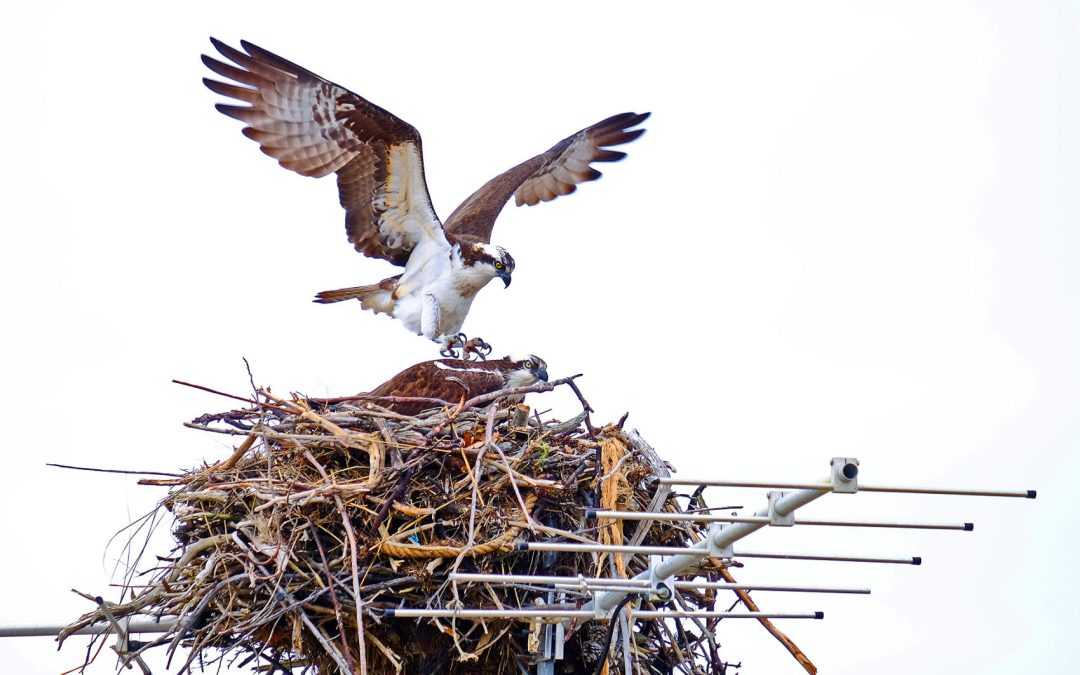By CRAIG GIBSON
One of the enduring signs of spring on the Cape is the annual return of the ospreys. The ospreys are a popular and common breeding bird. Each fall, at the end of the breeding season, they depart and head south on winter migration. They typically begin to return to their breeding territory on the Cape toward the end of March each year. This year the first documented sighting of a returning osprey took place on March 23, with a pair of ospreys being seen at the north end of Green Pond in East Falmouth. Over the next 10 days, many more osprey sightings were reported, particularly along Surf Drive, around Salt Pond and Oyster Pond, and even over in Quissett Harbor.

Picasa
Blue jay
The ospreys are one of the most iconic signs of spring for both birders and nature lovers. According to Mark Faherty at Mass Audubon Wellfleet Bay Wildlife Sanctuary, the number of osprey nests in Falmouth has doubled since 2005 to just over 100 occupied nests with breeding pairs. The Town of Falmouth has the largest breeding population of ospreys among the 15 towns on Cape Cod.
For most, the ospreys are among the easiest birds to identify. It is a joy to observe them, as they return in early spring and begin the process of building or rebuilding their nests, as they prepare for the upcoming breeding season. The osprey nests are frequently found in a range of habitats and in locations that make them easy to observe and enjoy. But, they are part of a much larger story in the birding world around the Cape, as many other birds are also returning for the spring breeding season.
Over the past year, with pandemic conditions in place, birding has expanded in leaps and bounds as a popular outdoor activity. For many, it is an enjoyable and relaxing activity that can include all ages, and all generations, within a family or among a group of friends. It is very relaxing and provides a great opportunity to exercise and be outdoors. It is oftentimes a very rewarding experience, particularly as the ability to identify different species begins to take hold and confidence builds. But for most, it’s an opportunity to connect with nature in a profound and meaningful way and it provides the simple enjoyment of being outdoors with others.
Cape Cod has a remarkable diversity of birds that visit throughout the year. In springtime, we see a wide range of migratory birds, seasonal breeding birds, and many year-round residents. In spring and fall, the Cape experiences an extraordinary number of migrant birds that are moving between wintering grounds and breeding grounds farther to the north. Over the course of a normal calendar year, the Upper Cape likely sees over 250 species of birds that make an annual appearance.
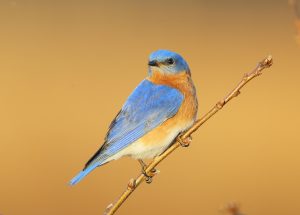
Picasa
Eastern bluebird
Local birding clubs and birding groups, as well as online birding and nature discussion groups, make it easy for both beginners and experienced birders to participate in a wide range of birding activities throughout the year. The Cape Cod Bird Club is returning to a regular series of outdoor walks in different locations. Local conservation and environmental groups like The 300 Committee, and Salt Pond Areas Bird Sanctuaries along with others, provide opportunities for nature and bird walks in the local area. In addition, many birding clubs and birding groups are now hosting online Zoom sessions with birding experts to share information on a wide range of birding topics. So, whatever level of experience, there are opportunities for everyone to get more involved in birding.
In Falmouth, we have a wide range of habitats that support different types of birding activities. For many residents, there is great enjoyment to be had in watching a backyard feeder and observing birds in the local neighborhood. At this time of year, in a typical local backyard, and perhaps around a feeder, you’re likely to see finches, sparrows, Northern cardinals, black-capped chickadees, tufted titmice, a Baltimore oriole, and perhaps a variety of different woodpeckers. The Cape has many open field areas, conservation areas, woodland areas, as well as freshwater marshes and saltwater marshes, along with sand dunes and barrier beaches.
Most birdwatchers quickly develop an interest in being able to identify the birds they see out in the field. Some have a natural skill for making accurate species identification, but inevitably it takes a lot of practice. A good field guide is an invaluable tool to have at your side to help build your bird identification skills. It is all about getting started, building confidence, and then with field guides, birding apps, and other resources, wrapping your arms around the fundamentals and getting lots of practice.
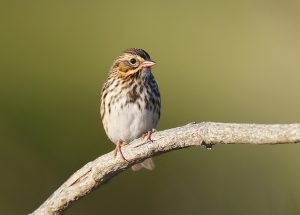
Picasa
Savannah sparrow
While birding out in the field, a momentary glimpse may be all you have to identify a bird. Making good observations of field marks by knowing which field marks to observe first, provides you with a big jump toward making an accurate identification. In general, you want to get a sense of these following characteristics: size, shape, color patterns, unique behavior patterns, the habitat that you find the bird in and any sounds it may make.
Here are a few tips for getting started with field identification. First, start by looking at the bird’s head with special attention to its bill and all markings on its face. Next, try to get a feel for the overall shape and size of the bird with any, and all, significant body markings. Next, look at the markings and colors on the wings, and the tail for any unique features. Finally, watch the bird fly away and again observe any unique markings. These observations will provide a solid foundation for making more accurate identifications of bird species out in the field.
There are ample opportunities for birding year-round. But let’s take a closer look at what opportunities might be provided in the months ahead. By knowing what you might expect to see, and the best locations to find these birds, your enjoyment out in the field will go up significantly. Let’s hope that the following local birding hot spots will help make your adventures as productive as possible.
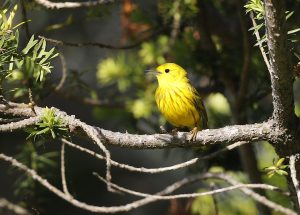
Picasa
Yellow warbler
In Falmouth and all over Cape Cod, May is the peak month for spring migration, and birdwatching can be outstanding in almost any location. After a night of southerly winds, you may find a new flight of colorful warblers in nearby thickets, eating as fast as they can to fuel the next flight farther north, and to breeding grounds. A multitude of warblers and many other songbird species make their way through the area in the middle of the month, with coastal shorebirds peaking a bit later toward the end of the month. Many of the resident birds are busy building nests, and some of the early hatchlings may even be seen by the end of the month. Keep an eye out for birds carrying nesting materials or food items back to possible nest locations.
For most species, June is the peak month for nesting and a good time to listen and identify bird songs. In waterways, ducks, geese, and swans can be seen with their newly hatched young, swimming around together and looking for food. By early July, most of the songbird eggs have hatched, and the parents are busy raising their young. Close to home, you may see adult robins or cardinals with their young hatchlings begging for food. In endless other locations around town, the ospreys can be seen bringing fish back to the nest and feeding their young. Along the coast, you may even notice the first southbound Arctic shorebirds beginning southbound migration after their short breeding season.
Let’s look at several birding hotspots around Falmouth that provide excellent birding opportunities in the months ahead.
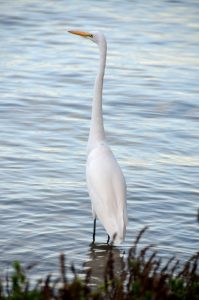
Public domain pictures
Snowy egret
1) Salt Pond: One of the top birding hotspots in Falmouth is in the area around Salt Pond. Salt Pond is located along Surf Drive between Mill Road, Elm Road, and the Shining Sea Bikeway. The 300 Committee (300committee.org) provides a description of Salt Pond and a trail map on its website. Over the next few months on a visit to the Salt Pond area and trails, you are very likely to see several different sandpiper species, gull and tern species, double-crested cormorants flying by, great egrets, snowy egrets, and great blue herons. On any visit to Salt Pond, you will inevitably see many osprey poles, nests, and many ospreys in flight. Common species in this location include house sparrows, song sparrows, red-winged blackbirds, a number of warbler species, gray catbirds, white-eyed vireo, and perhaps a willow flycatcher. In addition, you may see a green heron, great-crested flycatcher, and of course blue jays, tree swallows, robins, and cardinals. Finally, be on the lookout for the sight or sound of a belted kingfisher, particularly in the southwest corner of Salt Pond.
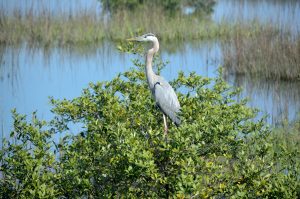
Public domain pictures
Great blue heron
2) The Crane Wildlife Management Area: The Frances A. Crane Wildlife Management Area is operated by the state Division of Fisheries and Game. It is located on Route 151 and includes over 1,800 acres. This location offers open meadows, extensive pine barrens and fields and wooded areas as well. It is the busiest birding location in Falmouth with more birder visits and recorded sightings than any other location. This is a great location to see rare nesting grasshopper sparrows and savannah sparrows. Frequent sightings of other species include the following: kildeer, American kestrels, Eastern kingbirds, tree and barn swallows, Northern mockingbirds, Eastern bluebird, American robin, American goldfinch, chipping sparrow, field sparrow, song sparrow, and Eastern towhees. Also seen are the colorful Eastern meadowlark, as well as many types of warblers, including the prairie warbler, common yellowthroat, and yellow warbler.
3) Peterson Farm: This birding hotspot is located just off Woods Hole Road near the Woodwell Climate Research Center. Here you will find beautiful open fields surrounded by pine and oak woods with many trails. According to The 300 Committee, the variety of birds, especially migratory birds, make the farm a significant birding hotspot in the Town of Falmouth. At this location, in the middle of June, you might expect to see a variety of hawks in flight overhead, swallows, wrens, blue jays, Eastern phoebes, and Eastern kingbirds. Many woodpeckers are present, including the Northern flicker. Other sightings might include house sparrows, American goldfinch, chipping sparrows, song sparrows, and Eastern towhees. You will likely see nesting Baltimore orioles, red-winged blackbirds, perhaps a brown-headed cowbird, and several warblers species including blue-winged warbler, common yellowthroat, and yellow warblers.
4) Shining Sea Bikeway: The bikeway is now almost 11 miles long and runs from North Falmouth all the way down to Woods Hole. It is used by residents and visitors of all ages throughout the year. The bikeway is filled with a variety of habitats including sweeping views of Vineyard Sound near Surf Drive as well as dramatic views out over Great Sippewissett Marsh and then Buzzards Bay in the distance. Along the full stretch of the bikeway, you may see many types of gulls, many species of terns, egrets, and herons, nesting ospreys, many species of woodpecker, flycatchers, vireos, blue jays, chickadees, titmice, swallows, wrens, sparrows, Eastern towhees, Baltimore orioles, red-winged blackbirds, and many types of warblers.
Falmouth provides a treasure trove of birding opportunities, especially in the spring and summer. Make more out of your time outdoors, keep your ears open to bird calls, and always keep your eyes on the skies!

